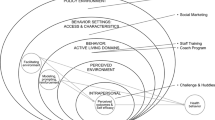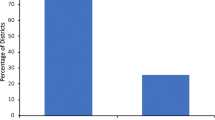Abstract
Background
Prevalence and consequences of obesity and sedentary lifestyle are well-documented public health concerns for youth in the United State of America (USA) that disproportionally affect children from low income and minority families.
Objective
This mixed-method study focused on estimating levels of physical activity and sedentary behavior and prevalence of overweight and obesity among the child members served in one Boys & Girls Club in the Midwest USA. We aimed to better understand opportunities for improving children’s engagement in physical activity through focus groups with members, staff, and parents/caregivers of members.
Method
Social cognitive learning theory, the ecological model of health behavior, and community based participatory research principles provided the study framework. Members completed assessments of physical activity, sedentary activity, height, and weight. Focus groups with members, staff, and parents/caregivers identified barriers, facilitators, and opportunities for promoting physical activity.
Results
Nearly 50% of members were overweight or obese. Most (87%) participants reported at least 60 min physical activity every day across the 3-day recall. Fewer than half (41%) reported 2 h or less of sedentary screen time every day across the 3 day recall. Focus group themes identified opportunities for addressing needs associated with health disparities in physical activity and pediatric obesity.
Conclusions
Findings suggest stakeholder interest in physical activity promotion through afterschool programs. We discuss study implications regarding needs specific to individuals from diverse, low-income households that may not be adequately addressed with existing empirically-supported treatments and opportunities to address health disparities in physical activity and pediatric obesity through afterschool programs.
Similar content being viewed by others
Abbreviations
- BGCA:
-
Boys & Girls Club of America
- BGCR:
-
Boys & Girls Club of Rochester, Minnesota
- BMI:
-
Body Mass Index
- CBPR:
-
Community-based participatory research
- RHCP:
-
Rochester Healthy Community Partnership
References
Altman, M., & Wilfley, D. E. (2015). Evidence update on the treatment of overweight and obesity in children and adolescents. Journal of Clinical Child and Adolescent Psychology,44(4), 521–537.
Bandura, A. (2004). Health promotion by social cognitive means. Health Education and Behavior,31(2), 143–164.
Barlow, S. E. (2007). Expert committee recommendations regarding the prevention, assessment, and treatment of child and adolescent overweight and obesity: Summary report. Pediatrics,120(Suppl 4), S164–S192.
Beets, M. W., Beighle, A., Erwin, H. E., & Huberty, J. L. (2009). After-school program impact on physical activity and fitness: A meta-analysis. American Journal of Preventive Medicine,36(6), 527–537.
Beets, M. W., Weaver, R. G., Turner-McGrievy, G., Huberty, J., Ward, D. S., Pate, R. R., et al. (2015). Making policy practice in afterschool programs: A randomized controlled trial on physical activity changes. American Journal of Preventive Medicine,48(6), 694–706.
Boys & Girls Clubs of America. (2019). About us. Retrieved from http://www.bgca.org.
Creswell, J. W. (2008). Research design: Qualitative, quantitative, and mixed methods approaches (3rd ed.). Thousand Oaks, CA: Sage.
Gao, Z., Chen, S., Huang, C. C., Stodden, D. F., & Xiang, P. (2017). Investigating elementary school children’s daily physical activity and sedentary behaviours during weekdays. Journal of Sports Sciences,35(1), 99–104.
Goh, Y. Y., Bogart, L. M., Sipple-Asher, B. K., Uyeda, K., Hawes-Dawson, J., Olarita-Dhungana, J., et al. (2009). Using community-based participatory research to identify potential interventions to overcome barriers to adolescents’ healthy eating and physical activity. Journal of Behavioral Medicine,32(5), 491–502.
Gordon-Larsen, P., Nelson, M. C., Page, P., & Popkin, B. M. (2006). Inequality in the built environment underlies key health disparities in physical activity and obesity. Pediatrics,117(2), 417–424.
Government of Australia, Department of Health. (2014). Australia’s physical activity and sedentary behaviour guidelines: 5–12 years. Commonwealth of Australia.
Grow, H. M., Hencz, P., Verbovski, M. J., Gregerson, L., Liu, L. L., Dossett, L., et al. (2014). Partnering for success and sustainability in community-based child obesity intervention: Seeking to help families ACT! Family & Community Health,37(1), 45–59.
Isreal, B. A., Schultz, A. J., Parker, E. A., & BEcker, A. B. (1998). Review of community-based research: Assessing partnership approaches to improve public health. Annual Review of Public Health,19, 173–202.
Jin, Y. C., & Jones-Smith, J. C. (2015). Associations between family income and children’s physical fitness and obesity in California, 2010–2012. Preventing Chronic Disease,12, 140392.
Jurkowski, J. M., Lawson, H. A., Green Mills, L. L., Wilner, P. G., 3rd, & Davison, K. K. (2014). The empowerment of low-income parents engaged in a childhood obesity intervention. Family & Community Health,37(2), 104–118.
Katzmarzyk, P. T., Denstel, K. D., Beals, K., Bolling, C., Wright, C., Crouter, S. E., et al. (2016). Results from the United States of America’s 2016 report card on physical activity for children and youth. Journal of Physical Activity and Health,13(11 Suppl 2), S307–S313.
Krieger, J., Allen, C., Cheadle, A., Ciske, S., Schier, J. K., Senturia, K., et al. (2002). Using community-based participatory research to address social determinants of health: Lessons learned from Seattle Partners for Healthy Communities. Health Educcation & Behavior,29(3), 361–382.
Krueger, R. A., & Casey, M. A. (2009). Focus groups: A practical guide for applied research (4th ed.). Thousand Oaks, CA: Sage.
Kumar, S., & Kelly, A. S. (2017). Review of childhood obesity: From epidemiology, etiology, and comorbidities to clinical assessment and treatment. Mayo Clinic Proceedings,92(2), 251–265.
Lambourne, K., & Donnelly, J. E. (2011). The role of physical activity in pediatric obesity. Pediatric Clinics of North America, 58(6), 1481–1491, xi–xii.
Ogden, C. L., Carroll, M. D., Kit, B. K., & Flegal, K. M. (2012). Prevalence of obesity in the United States, 2009–2010. NCHS Data Brief,82(82), 1–8.
Pate, R. R., & O’Neill, J. R. (2009). After-school interventions to increase physical activity among youth. British Journal of Sports Medicine,43(1), 14–18.
Robbins, L. B., Ling, J., Toruner, E. K., Bourne, K. A., & Pfeiffer, K. A. (2016). Examining reach, dose, and fidelity of the “Girls on the Move” after-school physical activity club: A process evaluation. BMC public health,16, 671.
Rochester Health Community Partnership. (2018). About us. Retrieved from https://rochesterhealthy.org.
Sallis, J. F., Condon, S. A., Goggin, K. J., Roby, J. J., Kolody, B., & Alcaraz, J. E. (1993). The development of self-administered physical activity surveys for 4th grade students. Research Quartery for Exercise and Sport,64(1), 25–31.
Sallis, J. F., Owen, N., & Fisher, E. B. (2008). Ecological model of health behavior. In K. Glanz, B. K. Rimer, & K. Viswanath (Eds.), Health behavior and health education: Theory, research, and practice (4th ed., pp. 465–485). San Francisco, CA: Jossey-Bass.
Sallis, J. F., & Saelens, B. E. (2000). Assessment of physical activity by self-report: Status, limitations, and future directions. Research Quarterly for Exercise and Sport,71(2 Suppl), S1–14.
Sallis, J. F., Strikmiller, P. K., Harsha, D. W., Feldman, H. A., Ehlinger, S., Stone, E. J., et al. (1996). Validation of interviewer- and self-administered physical activity checklists for fifth grade students. Medicine and Science in Sports and Exercise,28, 840–851.
Shalowitz, M. U., Isacco, A., Barquin, N., Clark-Kauffman, E., Delger, P., Nelson, D., et al. (2009). Community-based participatory research: A review of the literature with strategies for community engagement. Journal of Developmental and Behavioral Pediatrics,30(4), 350–361.
Skelton, J. A., & Beech, B. M. (2011). Attrition in paediatric weight management: A review of the literature and new directions. Obesity Reviews,12(5), e273–e281.
Skinner, A. C., & Skelton, J. A. (2014). Prevalence and trends in obesity and severe obesity among children in the United States, 1999–2012. Pediatrics,168(6), 561–566.
Strasburger, V. C. (2011). Children, adolescents, obesity, and the media. Pediatrics,128(1), 201–208.
Tremblay, M. S., Carson, V., Chaput, J. P., Connor Gorber, S., Dinh, T., Duggan, M., et al. (2016). Canadian 24-hour movement guidelines for children and youth: An integration of physical activity, sedentary behaviour, and sleep. Applied Physiology, Nutrition, and Metabolism/Physiologie appliquee, nutrition et metabolisme,41(6 Suppl 3), S311–S327.
U.S. Department of Health and Human Services. (2018). Physical activity guidelines for Americans (2nd ed.). Washington, DC: U.S. Department of Health and Human Services.
van Sluijs, E. M., McMinn, A. M., & Griffin, S. J. (2008). Effectiveness of interventions to promote physical activity in children and adolescents: Systematic review of controlled trials. British Journal of Sports Medicine,42(8), 653–657.
Wallerstein, N., & Duran, B. (2010). Community-based participatory research contributions to intervention research: the intersection of science and practice to improve health equity. American Journal of Public Health,100(Suppl 1), S40–S46.
Weaver, R. G., Beets, M. W., Huberty, J., Freedman, D., Turner-Mcgrievy, G., & Ward, D. (2015a). Physical activity opportunities in afterschool programs. Health Promotion Practice,16(3), 371–382.
Weaver, R. G., Beets, M. W., Hutto, B., Saunders, R. P., Moore, J. B., Turner-McGrievy, G., et al. (2015b). Making healthy eating and physical activity policy practice: Process evaluation of a group randomized controlled intervention in afterschool programs. Health Education Research,30(6), 849–865.
Wells, K., & Jones, L. (2009). “Research” in community-partnered, participatory research. JAMA,302(3), 320–321.
Wilfley, D. E., Tibbs, T. L., Van Buren, D. J., Reach, K. P., Walker, M. S., & Epstein, L. H. (2007). Lifestyle interventions in the treatment of childhood overweight: A meta-analytic review of randomized controlled trials. Health Psychology,26(5), 521–532.
Wilson, D. K. (2009). New perspectives on health disparities and obesity interventions in youth. Journal of Pediatric Psychology,34(3), 231–244.
Center for Disease Control and Prevention. About children’s BMI. Retrieved from https://www.cdc.gov/shealthyweight/assessing/bmi/childrens_bmi/about_childrens_bmi.html.
Zeller, M., Kirk, S., Claytor, R., Khoury, P., Grieme, J., Santangelo, M., et al. (2004). Predictors of attrition from a pediatric weight management program. Journal of Pediatrics,144(4), 466–470.
Acknowledgements
This research was supported by CTSA Grant Number UL1 TR000135 from the National Center for Advancing Translational Sciences (NCATS), a component of the National Institutes of Health (NIH). Its contents are solely the responsibility of the authors and do not necessarily represent the official view of NIH. We appreciate the contributions of all participants in this study, the support of Boys & Girls Club Rochester staff and board, and support from the broader membership of the Rochester Healthy Community Partnership. We are grateful to Marcelo Hanza and Tabitha Brockman for study coordination, Gladys Asiedu and Leslie Sim for assistance with qualitative analysis, Jane Rosenman for assistance with data collection, and Jennifer Weis for guidance and support for navigating the logistics of conducting research in academic-community partnership.
Author information
Authors and Affiliations
Corresponding author
Ethics declarations
Conflict of interest
The authors declare that they have no conflict of interest.
Additional information
Publisher's Note
Springer Nature remains neutral with regard to jurisdictional claims in published maps and institutional affiliations.
Electronic supplementary material
Below is the link to the electronic supplementary material.
Rights and permissions
About this article
Cite this article
Biggs, B.K., Tolleson, E., Millerbernd, J. et al. Identifying Opportunities to Promote Physical Activity in a Diverse Low-Income Population: A Mixed-Method Study at a Boys & Girls Club Site. Child Youth Care Forum 49, 171–200 (2020). https://doi.org/10.1007/s10566-019-09521-9
Published:
Issue Date:
DOI: https://doi.org/10.1007/s10566-019-09521-9




